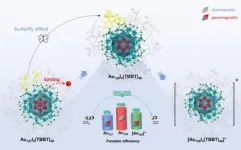(Press-News.org) Why this matters:
Arsenic levels in brown rice were found to be higher for U.S. consumers than in white rice, despite people often looking to brown rice as a healthier alternative.
There is significant arsenic risk for U.S. children under 5 who consume brown rice, as arsenic is a toxic chemical element that can lead to health problems.
Arsenic levels in U.S.-grown rice were found to be considerably lower than rice grown outside the country, suggesting there is concern to U.S. consumers who eat rice grown outside the country.
EAST LANSING, Mich. – Whether you buy rice at the grocery store or order a side of it while dining out, do you prefer brown rice or white rice? Or do you exclusively choose brown rice over white rice because you want to eat healthier, as brown rice contains more nutrients and fiber? Well, the answer to this question is not as simple as you might have thought, as it ignores a potential food safety concern.
According to new research from Michigan State University, published in the journal Risk Analysis, brown rice was found to contain higher levels of arsenic content and inorganic arsenic concentration than white rice among American populations.
While there are no major health risks for the general American public, there are potential health concerns for infants and children under age 5, as they consume more food relative to their bodyweights than adults.
“This research is important because it acknowledges the importance of considering food safety along with nutrition when consumers make choices about food,” said senior investigator of the study Felicia Wu, John A. Hannah Distinguished Professor and University Distinguished Professor at MSU’s College of Agriculture and Natural Resources. “While we found that choosing brown rice over white rice would result in higher arsenic exposure on average, the levels should not cause long-term health problems unless someone ate an enormous amount of brown rice every day for years.”
Research background and methodology
Arsenic is a natural component of the earth’s crust, and it is highly toxic. When compared to other cereal grains, rice has significantly higher contents of arsenic. In fact, rice takes up nearly 10 times more arsenic content than other grains.
This is because rice is often grown in continually flooded paddies, and wet soil conditions favor arsenic being taken up from the soil into the plants.
While the nutritional benefits of brown rice are well documented, white rice remains to be consumed more both in the U.S. and throughout the globe.
Therefore, Wu, along with postdoctoral research associate and lead author Christian Scott, both in the Department of Food Science and Human Nutrition, compared the arsenic exposure and associated risks between brown and white rice for U.S. populations.
Specifically, after comparing the nutritional aspects of brown and white rice, Wu and Scott used data courtesy of the “What We Eat in America” database of the U.S. Environmental Protection Agency and Joint Institute for Food Safety and Applied Nutrition to calculate average daily intake mean rice values for both brown and white rice.
The results provided insight into the difference in arsenic levels between brown and white rice as well as more complex data regarding how levels differed by region, highlighting where and what populations may be at increase health risk.
Geographic arsenic differences
The inorganic arsenic concentration of white versus brown rice was considerably different by region. For rice grown in the United States, the researchers found the proportion of the more toxic inorganic arsenic in white rice was 33%, and in brown rice was 48%; whereas in rice grown globally, 53% of total arsenic in white rice was inorganic, 65% of total arsenic in brown rice was inorganic. Organic arsenic, more commonly found in seafood as well as in other foods, is less toxic because it is readily excreted from the body.
There are also some populations who are more vulnerable due to elevated rice consumption or susceptibility to arsenic exposure. Specifically, this includes young children, Asian immigrant populations and populations that face food insecurity.
The values researchers found did indicate a potential harmful risk of arsenic exposure from brown rice for children under age 5 and as young as 6 months.
Interpreting the results
It’s important to not interpret these findings as evidence that brown rice is unhealthy, or that you should now consume only white rice, Wu said. Brown rice does contain important ingredients such as fiber, protein and niacin, which all benefit consumers.
“This exposure assessment is only one side of the equation when examining the potential trade-offs between brown and white rice consumption,” Wu said. “Even if arsenic levels are slightly higher in brown rice than white rice, more research is needed to demonstrate if the potential risks from this exposure are mitigated in part by the potential nutritional benefits provided by the rice bran.”
The researchers suggest completing an empirical analysis of the cost and benefits to societal public health by consuming brown rice compared to white rice. In their manuscript, they document additional key differences between brown and white rice, including prices, overall nutritional benefit and environmental burden.
Potential policy changes
Chronic exposure to arsenic over a lifetime may increase cancer risk. Therefore, this research raises the question about consumer behavior and public health. If more consumers were aware about arsenic concerns, then they may intentionally make different dietary decisions, especially when it comes to rice consumption.
As water is already regulated, the Food and Drug Administration’s Closer to Zero initiative will soon set action levels for arsenic when it comes to food products based on risk assessment to the American population. It is important for all consumers to be aware of arsenic levels in their food and understand that brown rice is a major source.
As Americans try to eat healthily and look to incorporate higher-nutrition content choices in their diets, this study challenges the notion that these choices are simply black and white — or in this case, brown and white.
By Jack Harrison
Read on MSUToday.
###
Michigan State University has been advancing the common good with uncommon will for 170 years. One of the world’s leading public research universities, MSU pushes the boundaries of discovery to make a better, safer, healthier world for all while providing life-changing opportunities to a diverse and inclusive academic community through more than 400 programs of study in 17 degree-granting colleges.
For MSU news on the web, go to MSUToday or x.com/MSUnews
END
MSU research: Eating brown rice increases exposure to arsenic compared to white rice
2025-04-09
ELSE PRESS RELEASES FROM THIS DATE:
Do “optimistic” versus “pessimistic” medical detection dogs perform differently?
2025-04-09
A new, exploratory study has revealed statistical links between the performance of medical detection dogs and their scores on behavioral and affective tests, finding that more “optimistic” dogs tended to perform better overall on detection tasks, but “pessimistic” dogs had higher scent detection specificity. Sharyn Bistre Dabbah of the University of Bristol, U.K., and colleagues present these findings in the open-access journal PLOS One on April 9, 2025.
Animal researchers commonly use a method called judgment bias testing to help assess animals’ emotional states. For example, dogs may first be trained to associate a specific location in a room ...
Multi-virus wastewater surveillance shows promise at smaller, site-specific scales
2025-04-09
In a new study, wastewater surveillance for multiple pathogens at five different sites identified local trends that were not captured in larger surveillance programs, and some sites used the data to inform efforts to prevent disease spread. Jay Bullen of Untap Health in London, U.K., Charlotte Hammer of the University of Cambridge and colleagues present these findings in the open-access journal PLOS Global Public Health.
People with viral infections produce waste containing viral RNA that ends up in wastewater ...
In addition to participation in school-based extracurricular activities, U.S. adolescents who participate in faith-based or community-based extracurricular activities may be more likely to identify th
2025-04-09
Scientists from Yale University report that in addition to participation in school-based extracurricular activities, U.S. adolescents who participate in faith-based or community-based extracurricular activities may be more likely to identify the risks of binge-drinking behavior, which could be an important consideration when developing preventions for excessive alcohol consumption.
###
Article URL: https://plos.io/4jHh7Dd
Article Title: Adolescent extracurricular activities and perception of risk of harm from binge drinking
Author Countries: United States
Funding: This study was financially supported by the National Institute on Drug Abuse (NIDA) (https://nida.nih.gov) ...
A new smartphone-sized device can test for tuberculosis. Here’s why that matters for children
2025-04-09
Tulane University researchers have developed a first-of-its-kind handheld diagnostic device that can deliver rapid, accurate tuberculosis diagnoses in under an hour, according to a study published in Science Translational Medicine.
The smartphone-sized, battery-powered lab-in-tube assay (LIT) provides a cost-effective tool that can improve TB diagnoses, particularly in resource-limited rural areas where health care facilities and lab equipment are less accessible. Over 90% of new TB cases occur in low- and middle-income countries.
This point-of-care device is the first to detect Mycobacterium tuberculosis (Mtb) DNA in saliva, in addition to blood and sputum samples. Saliva is ...
Scientists uncover spin–catalytic activity correlation in single-atom and -electron tailored gold nanoclusters
2025-04-09
Recently, a team of researchers from the Hefei Institutes of Physical Science of the Chinese Academy of Sciences (CAS) has consecutively removed the innermost atom and the outermost electron of a gold nanoparticle—without disturbing its overall structure. This precise manipulation allowed them to probe how the magnetic spin of the material influences its catalytic activity.
The work, led by Prof. WU Zhikun in collaboration with Prof. YANG from the Institute of Process Engineering, CAS and Prof. TANG from Chongqing University, ...
New research further translates the language of the genome
2025-04-09
New research has uncovered more about the complexity of human gene regulation by identifying certain sequences of proteins called transcription factors that bind to DNA and regulate the expression of human genes.
Published today (9 April) in Nature, researchers from the Wellcome Sanger Institute, the University of Cambridge and their collaborators explored how DNA-guided transcription factors interact with each other.
This research adds to the groundwork of understanding the complex language of the gene regulatory code, and how DNA sequence patterns located close to our genes influence human development and disease risk.
Each ...
How much food can the world grow? International team calls for new yield potential estimates
2025-04-09
An international team of agronomists is calling for a new approach to estimate crop yield potential and gaps — information that is critical in planning how to meet growing food demand.
University of Nebraska–Lincoln researchers made major contributions to the study, published online April 8 in the journal Nature Food.
“We are in a race to feed the world and to try to feed the population with the available agricultural land that we have,” said Patricio Grassini, Sunkist Distinguished Professor of Agronomy and one of the paper’s authors.
To ...
Could LLMs help design our next medicines and materials?
2025-04-09
CAMBRIDGE, MA – The process of discovering molecules that have the properties needed to create new medicines and materials is cumbersome and expensive, consuming vast computational resources and months of human labor to narrow down the enormous space of potential candidates.
Large language models (LLMs) like ChatGPT could streamline this process, but enabling an LLM to understand and reason about the atoms and bonds that form a molecule, the same way it does with words that form sentences, has presented a scientific stumbling block.
Researchers ...
Advanced genome sequencing enables genetic diagnosis for complex psychiatric conditions
2025-04-09
San Diego—April 9, 2025– In a manuscript published today in the American Journal of Psychiatry titled Long-Read Genome Sequencing in Clinical Psychiatry: RFX3 Haploinsufficiency in a Hospitalized Adolescent With Autism, Intellectual Disability, and Behavioral Decompensation, authors describe how they leveraged long-read genomic sequencing (LRS) to make a genetic diagnosis in a17-year-old male with autism spectrum disorder, intellectual disability, and acute behavioral decompensation that would not have been possible by standard methods. Through the use of LRS, a cutting-edge technology ...
Thoracic autonomic nervous system surgery current application—a survey among members of the European Society of Thoracic Surgeons
2025-04-09
Background: Thoracic autonomic nervous system surgery is mainly used for hyperhidrosis/facial flushing, whereas cardiac and vascular indications are limited. The literature remains controversial regarding the correct indications and surgical technique, with the lack of homogeneous data being a major limitation. We designed a survey to investigate current practice among members of the European Society of Thoracic Surgeons (ESTS).
Methods: A 29-question ad hoc questionnaire was available to all ESTS members from December 2022 to February 2023. ...



